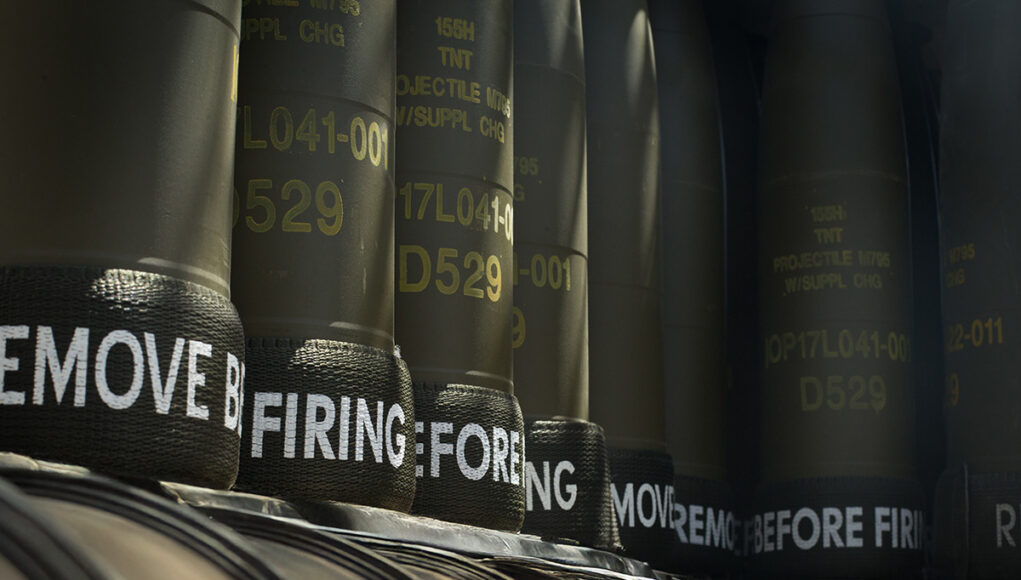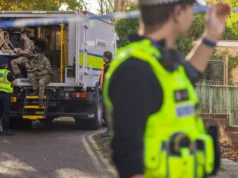The UK Government will invest £1.5 billion in the construction of at least six new munitions and energetics factories and procure up to 7,000 UK-built long-range weapons, supporting nearly 2,000 jobs across the country.
This major investment forms a central part of the upcoming Strategic Defence Review (SDR) and reflects a broader effort to rearm the UK for an era of high-tempo conflict and global instability.
The SDR, to be published in the coming days, outlines a comprehensive vision to strengthen Britain’s defence industrial base and military readiness. Drawing lessons from the ongoing war in Ukraine, the review concludes that an effective fighting force depends not only on frontline capability but also on resilient and responsive domestic manufacturing.
The plan sets out to ensure the UK Armed Forces can sustain operations and scale up rapidly when needed. Key commitments include:
- £1.5 billion to establish at least six new UK factories producing munitions and energetics—core components such as propellants, explosives, and pyrotechnics. These factories will generate over 1,000 new skilled manufacturing jobs across the country.
- Procurement of up to 7,000 UK-built long-range weapons, supporting an additional 800 jobs and expanding the UK’s strategic firepower.
This investment will bring total munitions spending to £6 billion during this Parliament. It supports the government’s broader Plan for Change, aimed at spreading economic growth and job creation across the UK’s nations and regions.
Defence Secretary John Healey MP said:
“From Faslane to Lossiemouth, the importance of Scotland to our defence capabilities cannot be overstated; it provides vigilance and protection for everyone across the UK. With threats increasing, the SDR is clear on the need to move to warfighting readiness to boost deterrence and to grow our defence industry across the country. Scotland will be a linchpin in making Britain safer, with more generations of skilled Scottish workers benefiting from apprenticeships, jobs and rewarding careers in defence.”
The SDR recommends the creation of an ‘always-on’ production capacity to sustain priority munitions. This permanent capability will allow the UK to replenish stockpiles quickly, respond to future threats, and maintain credible deterrence. The aim is to build long-term industrial resilience by providing a consistent demand signal to manufacturers.
Scottish Secretary Ian Murray MP emphasised Scotland’s vital role:
“As set out in the Plan for Change, national security is the first duty of the government so it is right that we’re supporting and strengthening the defence sector. We are entering a new era for our national defence and Scotland’s world-class industry is playing a big role in meeting that global challenge. Scottish defence businesses – with their skills, expertise and innovation – have a huge opportunity to benefit from this new investment with the sector here already receiving £2.14 billion in government spending last year, supporting approximately 25,600 jobs.”
The exact locations for the new munitions factories have not yet been decided. However, the government notes that Scotland already benefits from significant defence production—including 155mm artillery shells manufactured by BAE Systems in Glasgow and Tomahawk missile systems built by Raytheon in Glenrothes.
Chancellor of the Exchequer Rachel Reeves MP said:
“A strong economy needs a strong national defence, and investing in weaponry and munitions and backing nearly 2,000 jobs across Britain in doing so is proof the two go hand-in-hand. We are delivering both security for working people in an uncertain world and good jobs, putting more money in people’s pockets as part of our Plan for Change.”
The government says the SDR will end the “hollowing out” of the UK’s Armed Forces and place the UK at the forefront of NATO defence readiness. It sets a 10-year trajectory to transform the country’s defence posture—enhancing national security, boosting technological innovation, and reinforcing the UK’s global leadership in collective security.














Not with 3% by 2034, they won’t. It’s pin money. Seriously, an entire decade to add half a percent. We have no missile defence system for our cities and towns, no civil defence of any sort. Our navy is woefully undersized, don’t even bother with the army. Tempest might arrive but i’m not convinced they won’t do a TSR2. We have no capability to produce artillery or tanks. Meanwhile our drive to be ‘green’ gives us a huge national security headache and a giant bill.
That is why 3% by 3034 is just a cover.. they don’t want to give the public the bad news in one hit… nato is moving to 3.5% direct spend and 1.5% indirect investment by 2032 ( 34 at latest)…
It’s why he said at “least” 3% by 2034 at the “latest “.
Everyone is so use to government hiding that they are stripping funding from defence below what is safe that they are finding it difficult to comprehend that a government also has to hide they are massively raising it… because most of the public will have a shit fit when benefits are cut to buy bombs.
That last paragraph might well apply to me! Decades of lies, deceit and smoke and mirrors of HMG will take a while to have any impact on me while the cuts continue!
Everyone is in favour of higher taxes except their’s because they pay too much.
Everyone is in favour of benefit cuts but not theirs as they don’t get enough.
Then everyone complains their public services isn’t good enough and the military is underfunded.
This sums up UK politics for the last 100 years.
Yep – The ubiquitous UK White Van Man in particular seems to be adept at talking the talk regards defence – but prefers not to walk the walk when it comes to paying taxes.
All what you say is true however we all know the uk wastes billions and can afford to cut some things net zero is just a waste why are we giving billions away to other countrys have you ever heard the government say we can’t take anymore illegals anymore we don’t have the money no you have not they find money for that they can find money for defence it’s that simple we don’t have a tax problem we have a spending problem
As the saying goes, its the economy stupid. My son just paid £14k for 5 door 3 year old car petrol hatchback with 16k miles on the clock. If his previous VW is anythjng to go by he will get 200,000 miles and 10 years out of it. In the same showroom some punters were considering leasing a £35k EV which could easily be confused with a humvee and whose value will fall by 50% in 2 years – much greener though right 😂
Its BS that the country can’t afford higher defence spending.
Yes for you, me and many others the idea of cutting the military to the bone and the fact it was happening as threats increased was a form of insanity that the government hid behind smoke and mirrors.. but it’s important to remember for another even larger group the whole idea of increasing military spending is a form of insanity that the government now needs to hide behind smoke and mirrors… it’s a funny old world.
Seems Healey was indicating a nuclear battlefield weapon will be returning to the UK arsenal as a means to counter Russia’s breaking of the intermediate range ballistic missiles ban and deploying battlefield nuclear weapons to Belarus to threaten Poland and Baltic states.
If there is a return to lower yield weapons what will be the delivery platform? F35Bs or a small F35-A order? Or typhoon. Or storm shadow stand off capability?
It’s always dangerous going down this route as there is no substitute to having an adequately sized and powerfully armed military. That would be a better conventional deterrent but I do agree having a counter to Russian and Chinese low yield nuclear weapons is necessary now unfortunately.
Historically I believe it was cold war doctrine that if you were being overwhelmed by a larger force you would resort to tactical nukes but the battle space is changing. Ukrainian troops can’t poke their heads above ground for fear of Russian drones. Meanwhile AI enabled Ukrainian relatives of those drones are decimating launch platforms and logistics deep behind the front line. When the deep strikes have succeeded in drying up the supply of drones and shells one side or other will appear and take ground.
I don’t understand UK.. They are allied with the free world like the US, against Terrorism, and tyranny. Who are they preparing to fight for? Currently, the world is faces the barrel of countries under communist ideology and Islamic nation or terrorist group from those nations.
Also, UK is the most islamized country right now, with continued immigration of Muslims, and the rapid rise of Muslim population. also there are incidents of individuals roaming around implementing shari’a law, on the streets.
In short, UK is becoming more like the one they are fighting right now..
All this weapon upgrades will be just used against the free world when the time comes.. God forbid..
Another idiot who thinks racism is now permissible. Shouldn’t you be busy on a street corner handing out Reform Party leaflets?
I disagree that criticism of Islam is racist. Like traditional Christianity and Judaism it sees half of humanity as second class citizens and maintains this by genociding a further 5% of humanity.
This is what makes Christianity and Islam the two greatest evils in the history of humanity.
Where to begin… 🤷🏻♂️
• “UK is the most islamized country right now” – I think Saudi Arabia, Iran, Indonesia, Egypt, would all argue about that.
• “there are incidents of individuals roaming around implementing shari’a law” – There are always individuals who are prepared to act as vigilantes to enforce what they think should be the law. During the Troubles, we had paramilitaries on both Republican and Unionist sides ‘administering justice’ on their own communities. In both cases, those communities weren’t supportive of this, which ultimately undermined support for the paramilitaries causes.
• “maintains this by genociding a further 5% of humanity” – Do tell where is Islam currently commuting this genocide? The only ongoing genocides I’m aware of are the Chinese state against the ethnic Uyghurs (who are Muslims), and what’s now happening in Gaza. In recent centuries the most people probably killed by Muslims have been other Muslims, due to the rift between Sunni and Shia.
• “Like traditional Christianity and Judaism it sees half of humanity as second class citizens” – You clearly haven’t studied the basic teachings of either of these faiths.
• “makes Christianity and Islam the two greatest evils in the history of humanity” – Really? Ahead of racism, colonialism, Nazism/ Facism, Communism, you cite Christianity and Islam as greater evils. With that you lost any remaining credibility.
(The irony here, I’m no fan of Islam. Having studied its history, it’s clearly a political invention to increase the military power available to a wannabe workload after he was expelled from Mecca. That’s it still continues to this day is baffling. But that doesn’t give me the right to slander and insult those who sincerely believe it in good faith.)
Hello,
Replying here due to thread depth issues.
Your first two points are nothing to do with me?
Re 3 All these religions promote the torturing to death of non-heterosexuals. Since the Iranian revolution I believe 18 Muslim countries have reintroduced the death penalty or restarted enforcing it. This has been part of these religions since their invention as evangelical versions of Judaism.
Your ignorance and racism shows in your disgusting suggestion that Jews defending themselves against genocide is genocide.
Re 4 All these religions in their traditional forms promote gender based social apartheid with 50% of humanity treated as second class citizens in a way that makes ‘The Handmaid’s Tale’ look mild. The 5% they exterminate are to support this. Whether you see these abominations as revelations from God or human inventions is irrelevant. Real Christianity is what Christians do and real Islam is what Muslims do. Your apologist rereading of their texts does not matter.
Re 5 they have promoted slavery and abuse for women and children and death for non-heterosexuals, the bulk of humanity, for 3k yrs, 2k yrs and 1.5k yrs respectively and still hold sway over half of humanity. The other things you mentioned all added together have done less evil.
• Please provide the references in the New Testament that specifies homosexuals shoukd be tortured to death… This will of course be a long wait, because you cannot.
• In Leviticus there are prohibitions on homosexuality. You’ll also find references to ritual sacrifices of animals too. But they don’t happen any more either. Religions like all human activity, move on and progress.
• Is America a Muslim country? Is China a Muslim country? The latter is the world leading exponent of the death penalty.
• The clumsy wording you use shows that you know your position is untenable. Hamas seeks the eradication of Israel, and I suspect it would happily achieve that through genocide. I have no issue with the IDF eradicating Hamas. What I do have issue with the genocide of innocent Palestinian men, women, and children. This is the same issue than many in Israel also have with Netanyahu’s policy. That you think it’s “racist” to condemn genocide is a laughable strawman attack from someone too hysterical to argue rationally.
• The three Abrahmic religions have have been around far longer than Facism and Communism. But they never possessed the industrial scale ability to project evil that these atheistic political philosophies possessed. These atheistic authoritarian regimes have managed in a short time to far exceed all the evil ever done by man in the name of religion.
• Netanyahu and the extremists currently in control of the Israeli government seem to have forgotten Nietzsche‘s warning: “Beware that, when fighting monsters, you yourself do not become a monster”.
No matter how righteous your cause, it will never justify the murder of the innocent.
Your posts are just long lists of lies and I suspect you are too detached from reality to realise it.
90%+ of Christians (probably more like 99% historically) would repudiate your attempt to dismiss the Old Testament.
Hamas promotes a weird interpretation of Islam where its future depends on the extermination of Jews worldwide. This was well known in Gaza when the Fascist scum there elected Hamas by 57%. A level of support for genocide Hitler never achieved in Germany.
Israel are going after Hamas. Hamas is hiding amongst civilians to maximise their casualties knowing they can count on racist loons to blame Israel rather than them. There is no evidence of any intention of genocide on Israels part. From the racist lies you keep parroting I half expect you start going on about them using the blood of christian children in their rituals next. Same sort of lies.
No, my posts are long lists of what are known as “facts”. You should maybe investigate the concept of a “fact” sometime.
• Another straw man attack, I didn’t repudiate the Old Testament. But Christian doctrine is that the Books of the Old Testament were provided to the Jews, whereas the New is specifically for Christianity. Some evangelical nutjobs in the USA who believe in prosperity theology would disagree with that, but they’re regarded as heretics by the Christian mainstream.
• Wrong. In the 2006 election Hamas only got 44.45% of the votes, but the election system resulted in 57% of seats. They then abolished elections and have held none since. So no, you cannot claim that the Palestinian people are all Hamas, which is what you’re attempting.
• UK and Western forces are no-strangers to fighting terrorists. But we always seek to minimise civilian casualties and even cancel operations if the collateral risk is too high. They’d come by IDF carries on regardless.
(Or as we saw recently, will slaughter a convoy of unarmed paramedics simply because they’re Palestinian.)
• Like the supporters of all authoritarian regimes you conflate the identity of the state and the ruling party. I didn’t say Israel wants the genocide of the Palestinians, it’s the ruling party that does – part of Netanyahu’s attempts to stay in power and out of prison.
• It’s hilarious that you accuse me of being a racist for not condoning genocide against Palestinians, given that my views are the same as that of all of my Jewish friends who are horrified at Israel becoming an international pariah.
• But I’m not surprised. People who cannot support their position with facts will often play the race card as a last act of desperation.
The reality is of course, that you’re racist against Palestinians.
Back out nuclear and pensions and going to 3% is equivalent to +50% on conventional capabilty spend.
Completely agree with the above. It will all be over by 2034!!! We need 3% now rising to 5% by 2030. Providing the Armed Services the ability to plan the increases required in manpower, capability and equipment. We need some JFDI spirit!!!. Successive UK Governments have talked big on Defence delivery but never delivered it. Let’s not re-learn the lessons of 1930’s rearmament when only the RN was truly ready for war in 1939.
Maybe slightly OT, but the RN was nowhere near ready for war in 1939. Much of the battlefleet and cruiser fleet was old and awaiting modernisation, and most of the destroyers were also of WW1 vintage. It’s worth pointing out that this wasn’t for a lack of will or even money in the five years previous, but a lack of capacity due to the earlier reduction in shipyard numbers and the loss of much of the skilled workforce and institutional knowledge. This was despite the best efforts of the Admiralty, who subsidised a number of yards during and after the Depression while the Treasury looked the other way. The abject state of carrier aircraft, on the other hand, was a different matter…
Healey grandstanding again. 3% by 2034. 9 years away. Sounds exactly the same as the Tories saying they’d do such and such when they knew full well they’d not be in power so could say what they like.
So easy for politicians to talk, there might be a new lot in charge by then.
As for these 6 factories, will they be MoD owned like our DM sites or are we paying the likes of BAES to build and staff them?
Up to 7,000 missiles sounds promising.
The statement “The government says the SDR will end the “hollowing out” of the UK’s Armed Forces”
Hollowing out like Puma, Watchkeeper, LPDs, Waves?
Lets have some firm orders, facts, and plans laid for expansion of personnel, not soundbites which are always in the future.
You know it is going to hurt me to agree with you, right? I agree.
However, I’d suggest that the new 1SL will signpost the direction of the Royal Navy and whether we need the amphibs we had, he must be a subject matter expert. Puma was a tad dated – 50 years? However, to gap it, is wrong.
With the number of the fighty platforms we have, do we need such a big RFA? On the other hand, remuneration for the RFA needs to be sorted yesterday so they can provide the support for what remains of the Royal Navy.
Drones? Speak to Latvia! The evolution of drones is going at light-speed, and possibly it is something that should be gapped to allow us to catch up (oxymoronic?) – you can have a legacy rifle, legacy grenade etc, but, drones? They are quickly out of date.
I don’t agree we need F35A, the carriers fitted for and with F35B with enough reserve pilots would be my thoughts and more Typhoons, the cash being spent in the UK and Europe not America. Likewise, we need a resilient pilot training scheme.
When Latvia can build ASCOD, then ask GD to foxtrot oscar, the braid to wind their necks in and buy ASCOD; use the money saved to invest in Royal artillery air defence; although the list is endless across the services including more T26 (not going to happen) more SSNs (not going to happen).
So, I do agree with you and tomorrow will be empty words and money spent on three already overpaid, life expired, ‘mngt consultants’ delivering nothing.
Until we can find the cash to really scale up procurement, this is still a step in the right direction.
This is such an obvious move so why wasn’t it implemented a decade ago?
Realistically Defence couldn’t actually spend the money sensibly before then…
We still need reform of the procurement system…and programme management.
As to the 6 factories…..I’d bet my house most are already announced…
Glascoed expansion
Washington expansion
MBDA Bolton expansion
Roxel expansion
Rheinmetall barrel factory in Telford
BAE barrel factory in Sheffield
I bet thats it…
If we were really serious we’d have another propellant explosive factory…a small arms factory for Grayburn….a small munitions factory (grenades and rocket launchers like Hunting and RO used to do..)….another small arms ammo factory to complement Radway Green….and a new armoured vehicle factory (unfortunately they’ve now started to build houses on ROF/Vickers Leeds)….Thales would expand in Belfast….and we’d get a new large solid rocket motor factory…
Thanks for that list. Was aware of all except for Roxel??
So this is in effect more spin, the factories already exist!
The headline implies building news, thus new sites.
Not expanding existing! 😆
Good points regards procurement and management, nothing is quick. And thus subject to alternation on the quiet after all the grand announcements.
Not confirmed…but I suspect that is the reality…
They don’t all exist though…some are recent announcements, others are in build though (BAE Sheffield and Washington).
But…in truth compared to where we were 3 years ago this is all still welcome…
Getting rid of obsolete equipment is not “hollowing out”. Otherwise the British Army would still have regiments of pikemen and archers, the RAF would have dirigibles and the RN three-decker sailing ships…
Hi Spock. Ha. I can see it now, using that stuff!
Of course. It also depends if they are replaced.
Usually outdated equipment leaves and new comes in, in a ling planned for staggered fashion where some old is still used as the new supplements the existing.
But that is not happening here is it.
So:
LPDs. What replaces them? They are not old, nor obsolete, nor outdated. Other navies, including the USN and European navies operate them.
At best, gapped, as MRSS is years away and not even confirmed.
Puma. Old, yes. . A medium sized helicopter capability isn’t obsolete. Where is the replacement?
At best, gapped, with NMH.
Waves. Not old ships, they came in when the old Leafs and Ols were going out of service.
Not replaced. And they’ve not been “replaced” by the Tides either, as I heard a minister claim once, in a typical moving the goalposts move…they replaced the Rovers.
Watchkeeper. Troubled, yes, difficulty training crews. Recently updated with Ground Surv Radar I believe, to queue Apache onto targets. The vehicle is vulnerable, there wasn’t anything wrong with the tech.
Watchkeeper is still in use, as there is nothing else to replace it in Estonia.
Protector and Reaper are no less vulnerable. Why are they not called obsolete?
With respect, you sound like Ben Wallace talking of “sunset capabilities” as a euphemism for cuts, getting rid of:
Hawk T1. Still used elsewhere, and as able to do the aggressor role as the contracted aircraft that “replace” it.
Hercules. Still used, happily bought by the Turks believe. Obsolete? Is support of SF obsolete? No.
That Atlas can be diverted doesn’t make it a just decision, a lady RAF AVM fought hard to save them from the Tresuary axe.
Sentry. Gapped.
Sentinel. Gone. Just when its JSTARS type capability might have proved useful.
Islander and Defender. Same kit, same role, airborne surveillance in support of SF and CT roles. Moved entirely to Shadow and Met Police Cessnas which now have more hours thrown on them.
The term “Hollowing out” I first heard being used by Healey when in opposition.
I suggest hollowing out, rationalised, modernised, are just government speak for cuts.
• Other navies might be keeping LPDs, but since when has the RN been a follower rather than a leader? We aren’t going to do large-scale opposed landings in future, so what are the LPDs for? The MRSS will fulfil the role for the RM’s returning to raiding missions. Point class (and their replacements) fulfil the sea-lift role. Even if a role for the LPDs could be found, the existing vessels would need replacing. Their age makes maintaining their machinery increasingly difficult and expensive, and lack of automation means a crew complement equivalent of two Type 26 frigates.
• Puma, 1970’s design which despite a refresh in 2010’s is getting increasingly expensive to maintain. The only issue here is that Puma is being retired in 2025 and while H145 has replaced it in Cypress and Belize, there’s nothing yet identified for the wider NMH programme.
• The Tide class replaced the Rover class, as fast-fleet tankers. But given the RFA can’t crew all 4 of the Tide’s it has, it has little chance of ever generating crews for the Waves, especially once the FSS ships are delivered. But while the RN is sorely missing FSS, as seen on CSG 2025, there’s no indication that it’s operations are missing tankers.
• Watchkeeper has been a mess. Classic example of trying to improve and localise an existing platform and ending up with something unreliable (Ajax springs to mind). Overbudget, late, and a tendency to crash (8 lost). Only the Romanian’s were daft enough to buy a handful of locally assembled Watchkeeper. Watchkeeper is not still in use, it was retired two months ago. My own concern is what it will be replaced with, and ensuring no repeat debacle.
(Yes Protector is just as vulnerable to enemy action, but can fly in controlled airspace… and fly without crashing too.)
• I didn’t say Hercules was obsolete, as it wasn’t listed in your original post. But the ones we had were knackered from overuse. Now the A400M’s are past their teething troubles, reducing operating costs by only operating one tactical airlift is an obvious no-brainier. That said, there should be an order for more A400Ms to maintain lift capacity.
As for special forces, JSFAW only operate helicopters for SF ops.
• The E-3 Sentry was 30 years old, and based on an airliner that ended production in 1978. We saw in 2006 over Afghanistan what happens when you operate a militarised version of long obsolete airliner. We have E-7 Wedgetail replacing them, the only issue here being the gap between retirement of the old E-3 and introduction of the E-7.
• Sentinel, only 5 ever produced seventeen years ago. By the time they were sold on, they were no-longer airworthy. Protector and Poseidon to fulfil role.
• Shadow is replacing Defender and number being increased to 8 under the Mk2 programme.
Wouldn’t be surprised to see a F-35A buy in the SDR. Sunday press reports hinting at B61.
It seems likely. There’s been rumours for a while about procuring the F35A. But the question was whether they’d add more Typhoon orders to keep the production line busy.
Maybe it will be a mix. But the F-35A is a big improvement over the B model, and that gap will only widen.
Lakenheath has new nuclear weapons storage sites in build after the rumours of the US stationing B61 there. So it makes a lot of sense for the RAF to simply join that development. There’s plenty of space now the F-15s are leaving in a few months.
F-35A only makes sense if we’re ordering a lot of them, e.g. 150+ for combined A&B models.
Otherwise you have two OCUs, two pools of spare airframes, and actually end up with fewer frontline aircraft than just having all Bs.
It’s a trade off but I don’t think you need a massive order. There’s still a lot of shared logistics with the B, and Lakenheath has A models already with helps a tiny bit. The rumours are a buy of 24 F-35A, and we only have 48 Bs planned.
When it’s providing a new nuclear deterrent option, and better long range strike with the larger bays that probably feed into GCAP then there’s a lot of benefits.
That would be an illogical decision. It does nothing to improve the under strength carrier fleet, it doesn’t bring the integration of UK weapons any nearer and it fragments still further the combat air fleet. A further buy of Typhoons makes more sense- vastly greater UK industrial input, UK weapons already integrated. This is not the time to increase our reliance on US supplied equipment.
I’m with you on that. We don’t need to panic buy and add yet more complexity to our logistics. Adding additional Typhoon makes much more sense on so many fronts, no least the segue onto Tempest.
A strong defence industrial base = a strong military. 😎 It ain’t sexy but along with logistics it’s the foundational base for the pointy bits.
Ukraine is now looking in a much better shape given the increase in support so we need to focus on making smart decisions for the medium and long term.
Those who advocate rushing recapitalisation by simply reconstituting the armed forces of the past are going to cost us more money in the long run. The world is moving on but it’s not yet clear in what ways.
Anyway, my 2p worth.
If the yanks can entice Japan with an offer of a new plane (I saw that somewhere?) and offer us F35A in order to fulfil this new UK Nuclear Strike requirement then I would suggest GCAP would – unfortunately- be dead in the water.
As they have done many times America only seeks to increase their manufacturing base and others dependency.
UK has largest defence budget in Europe but smallest military – why?
Short answer is we have to have the most niche,gucci and expensive kit out there and then wait decades for it to be delivered and then not in the numbers required! HTH 😀
The more accurate answer is the cost of nuclear capabilities – something shared with France which has a similar defence budget. With a much smaller budget, Italy, with no nuclear costs, actually spends more on conventional defence equipment than UK.
We seem to keep forgetting this. The Dreadnought programme will be eating up the procurement budget over the next decade.
One key strand of thinking must be around ‘doing’ nuclear deterrence in a much more cost efficient way. It’s vital but so, so expensive to do in a credible way.
Collaboration with France makes a lot of sense to share costs and technology and burden sharing with other European neighbours may also help.
I personally think we also need to have a tactical option as the French do – it gives so much more flexibility in your response to an ‘aggressor’ (i.e. Russia!).
Because we use the budget to bung money to whichever industry is flavour of the day. Endless studies, assessments etc that result in nothing, billions upon billions leading to nothing.
This! Added to my list below.
Carriers. Nukes, so the DNE, AWE, and so on. Oversees bases, 5 eyes high tech, SSN, SSBN, expensive wages P&C, political incompetence, UKSF, Cyber, R&D, a military meant to be expeditionary ( unlike Finland or Poland ) Tempest, ( 12 billion alone to develop ) large network of legacy bases and infrastructure that costs a fortune, and a logistic tail that actually allows us to use our military around the world rather than sitting at home at barracks counting shiny toys without the professionalism, experience and logistic tail to use them ( applies to many nations. )
your missed out the SA80 debacle, and AJAX …….
SA80 “debacle” did not cost that much to fix and the fix happened 25 years ago.
Certainly not a drain on the budget anymore
… Luxembourg probably wants a word…
Why close the Royal Ordnance Factories in the first place? Most of the sites have been turned into housing estates. More £billions to be spent rebuilding them
They were privatized by Thatcher but closed down by the private sector, mainly BAE when orders dried up as part of the peace dividend. I felt at the time that this was a privatisation too far and so it has proved. From being a defence equipment exporter of a wide range of products, we now rely heavily on foreign countries for things like naval guns, IFV engines, new machine guns etc. It will be interesting to see whether we regenerate the capacity to build the planned replacement for SA80
Hate to agree with Trump but a 5% UK spend is needed, and needed now. Increasing the army size (includinding hardware), increasing weapons/munitions stockpiles, another 50, half each of Typhoons and F35s, couple more each frigates and destroyers, a continuous weapons production agenda… nice to see those North Sea drones to protect underwater cables, etc.
OK, not going to get anything like that lot, but I’m inclined to think that these are not optional extras, they are essential. Stage 1, we have to get back to having the armed forces we should still have now but haven’t, then we need the extras to take us where we have to be based on the current and future threats.
Hi Rob,
If we go to 5% we’ll (finally) need a grown up discussion about taxes and the impacts of the worsening socio- demographics on our economy and tax base (an increasing proportion of the population is getting old and infirm and so more costly, while we have fewer and fewer people of working age to fund everything).
Cutting things like disability benefits won’t generate that much in savings so if we want more spend on defence it’s needs big structural changes, some combination of higher taxes and reduced spend on state pensions/ healthcare spend on the elderly would shift the dial.
Personally, I’d just put taxes up (pensioners may moan a lot but a lot of them are good eggs), but the squeals of anguish from the plastic-nationalists and assorted flag shaggers would be deafening.
They’ve certainly never fought for their country (and they didn’t even have to do national service) and they’ve certainly no intention of being even slightly inconvenienced by paying more tax, thank you very much. That second home/holiday doesn’t fund itself, don’t you know.
Ask not what you can do for your country but..how you can dodge doing your bit!
In an ideal world, we should indeed be moving rapidly to a 5% spend to rebuild the force numbers and equipment. But governmental spending plans, like politics, is the art of the possible.
HMG is strapped for cash in virtually every department, schools, roads, housing, prisons, social care etc, etc. There is a massive backlog of funding needed just about everywhere, following the Tories’ 14 locust years of underfunding virtually everything
For defence, the first thing is to get public buy-in to the need to switch resources from the welfare state to defence. Healy is making the case, helped by support from the opposition.
Increasing spend in the next two years from the current 2.34% to 2.5% is a pretty small amount. It’s a 7%.increase. So Healy’s first moves look to be fixing the foundations, service pay rises, housing repairs, recruiting reform, plus building up our munitions manufacturing capability and investing in new-generation weapons like long-range fires, UAVs, UUVs, cyber defence. That all looks like the essential building blocks.
If the UK had the money to go to 3% or 3.5% now, a lot more could be done. But the UK doesn’t have the money and we are maxed out on borrowing.
Still sounds like Healy wants, over the ten-year SDSR timetable, to increase the size of the army by 2,000, add up to 6 more escorts, order two dozen more.fighters. likely F-35A, increase the number of voluntary reserves and so on, all useful little additions.
It is nothing I’ve the progress we need, but at least we are heading in the right direction, after 14 years of pretty savage defence cuts.
For ‘Healy’, read ‘Healey’, must get the SoS’s name right…
There are many things I’d like to come out of the SDSR but 1 thing needs to be made clear – that the Conservatives should never again be given responsibility for looking after the nations Defence. They single handedly have hollowed out our services.
As for the article – this move makes sense giving us great self sufficiency.
They believe far too much in the mystical powers of the free market and the private sector (along with the inevitable consulting fees) to care about putting any actual effort into building a string and industrial base and Armed Forces.
That sounds too much like socialism (or god forbid, even Marxism) as far as they’re concerned!
Useless ideologues.
“They single handedly have hollowed out our services.”
Hmmm.
There were 12 Fast Jet Sqns when they came in.
When Labour came in there were around 23.
There were 19 RN Escorts, when Labour came in there were 35.
On the Army side, nothing of note beyond RE vehicles was ordered between 1997 and 2010, leading directly to the state of Army vehicle and artillery fleets today, much like the Tory responsibility for delaying T23 replacement, there are knock ons.
Both are as bad, nothing single handed about it.
I’m no fan of Labour but they ordered the QE class. Conservatives cut t22s, MARPAT, t23s, GR4, Harrier, Sentinel, C130…the list is endless of all capabilities and assets cut. Labour not blameless but Conservatives have been ruinous
Very much so. 2010 was a smack in the teeth, my wife still says she never saw me more depressed.
13 years of Labour cuts and then the Tories come in, vowing the earth ( much like Labour now ) and cut.
I’ve offered to do a 97 to 2010 and 2010 to 2024 cuts comparison list before, Labour supporters previously for some reason disagreed.
Labour ordered the QEC Class, and then wasted 1 billion delaying it.
Tories cut 4 T22, Labour cut 3 T23s, and previous B2 T22s, and half of the planned 12 T45s.
Labour cut SSN from 12 to 7, yet vowed 8.
Labour had the SABR, Brown robbed the cash by cutting heli budget and just robbed the RAF of its Merlins to “replace” the FAAs Junglies.
Tories cut GR4, Labour deleted some of the Tornado F3s, all Jags, some Harriers, and all the Sea Harriers. “Tories cut the Harriers” always gets me, as much of the force had already gone by 2010 but everyone conveniently ignores that and only remembers Camerons axe of what remained.
Labour reduced the RAF Typhoon T3 buy.
Tories cut Sentinel, Hercs, most Hawks, Defender
Islander, gapped AWCS.
Tories cut or gifted 5 Regiments of AS90, Labour cut 1.
Tories cut many Tanks, yet that process started pre 2010 when 19 Mech was changed to 19 Light ( a cut which enabled thrm to dispose of Armoured and SP Artillery )
Labour presided over FRES and wasted a billion faffing about, then dropped Boxer.
Labour didn’t advance any RA programmes, Tories chopped Fire shadow.
Tories allowed RFA to wither, a process started by Labour.
Labour vowed 22 more Chinooks by closing Cottesemore and culling much of the Harrier force, Ainsworth didn’t follow up with that order.
Tories did, but only 14.
BJ started big investments into nuclear warheads and the AWE, left to rot for years.
On manpower, overwhelmingly blame at the Tories door with 5k each RN and RAF post 2010 and big army cuts.
Labour cut 12 escorts, Tories cut 4, then others, the T23s, fell apart so numbers dropped as Tories didn’t get on and build T26.
Tories cut Ocean and reduced LPD active to 1. Labour finished the job.
Labour cut Puma.
The Tories cut Nimrod MRA4, yet people forget Labour had already reduced the order from 21 to 9.
Tories however have ordered the new ER Chinooks and bought 16 Protector. Labour will be cutting Watchhkeeper.
Labour replaced 150 plus Gazelle and Lynx with….34 Wildcat.
On bases, both as bad as the other re closures of facilities.
Where does it end?
Where does one draw the line?
They’re both as bad, no party political bias from me, I go by the ORBAT and what vanished when.
And until all this grandstanding by Starmer and Healey about so much % being spent materialises into firm orders for new kit and assets, I’ll have the same view about this lot.
yes what a list!. add on cuts to training and the depth of the cuts is worse particularly for FJ and rotary. Doesn’t matter how many orders are placed in there’s no-one to fly them…and all at a time when talking tough! blame is across the political divide – and to think the Conservatives once called themselves the ‘party of defence’
That, they most certainly are not.
Not any more, not with their record.
The Tories are not blameless, but Labour oversaw even bigger cuts during their last time in power (albeit from a bigger starting point). Their general rhetoric has generally been anti armed forces too over the past couple of decades (certainly moreso than the Tories), which makes it harder for us to generate the politcal and public will to get things back on track again.
I know everyone is going how on only 3%
But as I have said the 3% by 2034 is simply a smoke screen..
We all know the vast majority of the public cannot stand spending money on defence so if any government tells them defence spending is going to be 5% within the decade and ohhh we are cutting benefits that government is toast…
So he’s simply putting up a smoke screen and warming up the public.. that is why they keep mentioning jobs jobs jobs..
It’s why they made the statement at least 3% by 2034 at the latest.. they know NATO minimum is going to be 3.5% +1.5% by 2032 or maybe 2034.. so they are laying down a bit of pain now.. showing how it means jobs ready for the real pain latter..
Just look at what is being announced 10s of billions of capital investments, 2000km UK missiles new munitions factories… we have to remember most of the public think building bombs and not welfare is a pile of shit … and if that pile smells like shit it’s going to be shit even if a politician tells you otherwise… it’s just now the pile of shit is Massive increases in defence spending.. not hiding massive cuts in defence spending..
We need to turn the “Buy British” slogan into government policy (yeah I know there’s a few problems with that) but it’s a start!
Talk remains cheap, too little too late and the younger generation are totally disengaged and living a drug induced fantasy world on Netflix while moaning about how everyone hates them. Until the government gets serious and puts the wind up the public they will not take the threat seriously so better start learning Russian.